Banana bread recipes are some of the easiest to follow and considered a "go-to" baked good to make, even for novice bakers. Yet sometimes, banana bread recipes can go wrong. They might sink, they brown too much in the oven, they don't rise, they are under-baked in the middle or gummy at the bottom, they don't taste right.... Here's a post to explore what can go wrong with banana bread and how to improve your recipe next time!
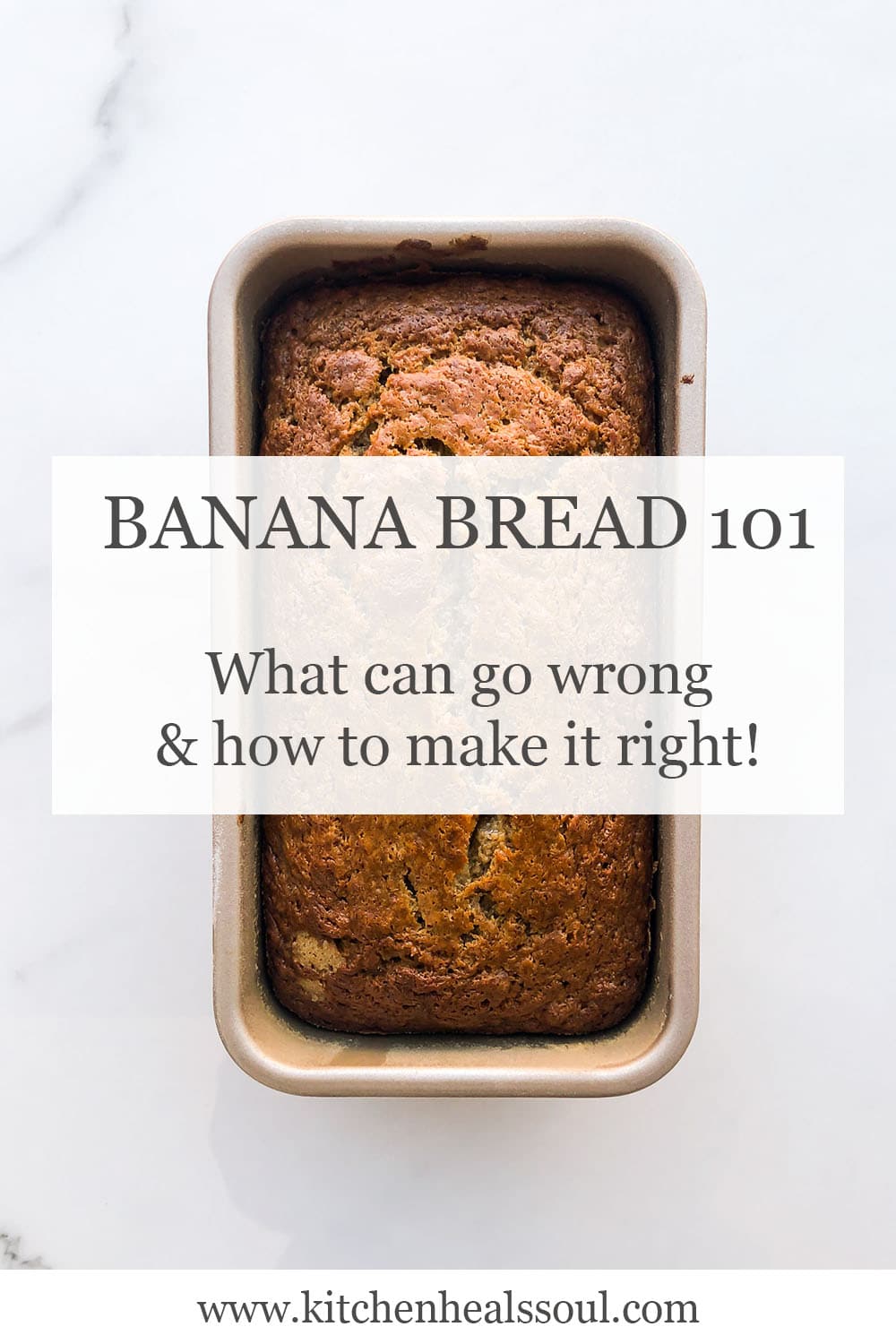
Jump to:
- Banana bread 101
- Problem #1: it sinks
- Problem #2: it browns too much
- Problem #3: it doesn't rise
- Problem #4: there's a gummy layer towards the bottom of the loaf
- Problem #5: it doesn't taste like bananas
- Problem #6: it's hard to tell when banana bread is baked through and done
- Problem #6: baking banana bread in different pans
- Problem #7: it seems a little dry inside
- 📖 Recipe
Banana bread 101
Banana bread is essentially a banana cake, made just like any other cake with the same basic ingredients (butter, sugar, eggs, flour, chemical leaveners) and the addition of mashed bananas. It's referred to as a bread because it's baked in a loaf pan. Still you can bake the exact same recipe in a muffin pan and call it banana muffins. Or you can bake that recipe in a cake pan and call it banana cake.
The basic banana bread formula
Most banana bread recipes have the same formula, roughly: 115 grams (½ cup) butter (or oil) + 200 grams (1 cup) sugar (white or brown) + 2 large eggs + 2 or 3 mashed bananas + (190 grams) 1-½ cups flour + 1 teaspoon baking soda + ½ teaspoon salt. Some recipes may include less bananas and a little milk to compensate, others may include an acidic ingredient, like buttermilk or sour cream, which are tenderizing ingredients that may reduce gluten formation during the mixing stage. Some may add cinnamon, nutmeg, or even cardamom for flavour, and vanilla extract too. And some recipes might have more flour. But most banana bread recipes actually follow the same formula.
The mixing methods vary
Some recipes will use the muffin mixing method to make banana bread: all wet ingredients are whisked together in one bowl, and all dry ingredients are whisked together in another bowl. In the muffin method, the wet ingredients are added to the dry, and slowly mixed in, just enough to make a cohesive batter without overworking it. Usually, cakes made with the muffin method call for either neutral vegetable oil (like canola), melted coconut oil, or melted butter, and these are incorporated with the liquid ingredients.
Others will use the creaming method, which is the most common mixing method for cakes and helps you mechanically incorporate more air into the batter before the cake goes in the oven. To make a banana bread using the creaming method: the butter and sugar are whipped together until light and fluffy (this can take 5 minutes or more of beating them together), then the eggs are mixed in, one at a time, followed by the mashed banana, and finally the dry ingredients.
The banana bread recipes and methods are straightforward, and yet a lot can go wrong. Here's a deep-dive into all the problems that you may encounter while make banana bread, what you can do now (or next time) to make your banana bread better.

Problem #1: it sinks
The trouble with banana bread is that, sometimes, you might notice it sinks or sags in the middle. There are five reasons why you might end up with sunken banana bread:
- the ingredients in your banana bread recipe aren't properly balanced: when I say "balanced," I mean your recipe might have too much of the wet ingredients or not enough of the dry ingredients. The batter has more moisture content than it should and there aren't enough structural ingredients (mainly flour) to trap the air (steam from evaporation of water and carbon dioxide), leading to a wet loaf cake that may rise and collapse. This excess moisture could come from inconsistencies when measuring baking ingredients.
- your banana bread recipe doesn't mention the volume of mashed bananas, nor the weight of bananas you should use: The trouble with most banana bread recipes is they will tell you to use 3 bananas or 2 large bananas, but who knows the size of those bananas. Descriptors like "medium" or "large" don't help because those quantifiers are all subjective and relative, hardly an exact measurement. And if you add too much banana, you may end up with too much moisture in your banana bread and structural problems, making it next to impossible to bake off that excess moisture in the oven. Inevitably, your banana bread will sink.
- your banana bread recipe might have too much chemical leavener: Leavening agents help your cakes and quick breads rise and you need to use enough for the quantity of ingredients present in your recipe. On the other hand, too much baking soda or an excess of baking powder will lead to too much gas forming in your baked goods which will rise too quickly and fall, causing cakes to sink because the banana bread doesn't have enough structure to support and hold the volume of gas formed. The air escapes from the still raw batter and the banana bread sinks back down. And the problem with this is the chemical leavener is used up and lost, and so the banana bread can't recover from the fall.
- you topped your banana bread with a halved banana: slicing a banana in half, lengthwise, and placing the banana halves on top of a banana bread before baking is a very trendy way to gussy up banana bread. In fact, for the longest time, all I saw on Instagram were banana breads topped with bananas. That banana can cause your bread to collapse underneath as it bakes: the banana bread batter becomes more fluid as the temperature rises and it becomes more delicate as gases are formed when the chemical leaveners react, and since the bananas on top are quite heavy, the banana bread may collapse underneath
- you pulled it out of the oven too soon: if your cake hasn't finished baking and you remove it from the oven, the structure hasn't set and your cake is likely to collapse.
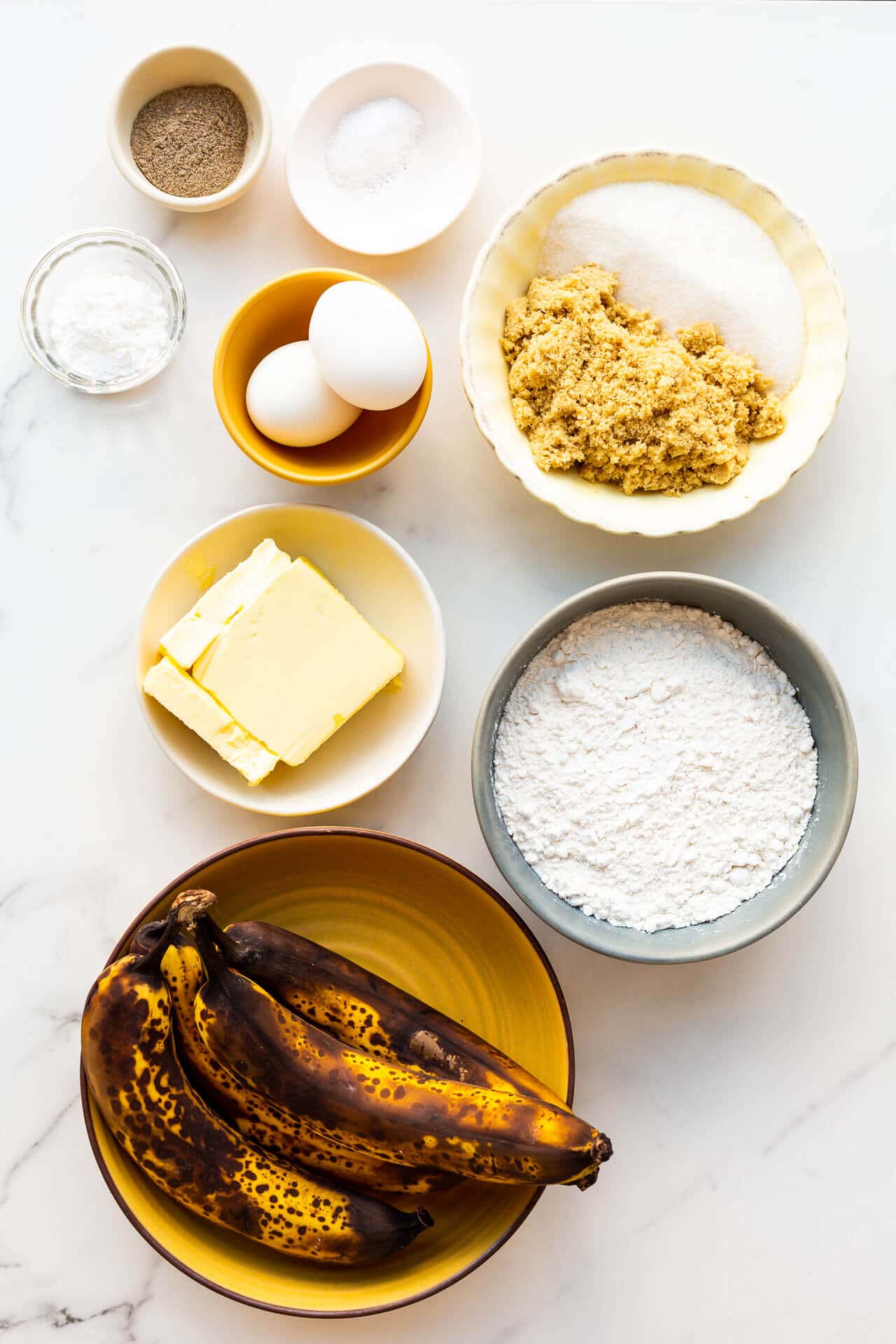
What to do if it sinks
If you've retrieved your banana bread from the oven and it begins to sink, there isn't much you can do. The damage is done and you can't stop it. But what you can do, is take a step back and look at your recipe. Analyze the ingredient list, compare it to other banana bread recipes in your cookbooks or on your favourite sites.
If you cut into your banana bread and you realize it's collapsed and still wet inside, it may mean that you didn't bake the loaf for long enough. Consider what methods you used to judge if the bread was baked through. Learn how to test a banana bread to see if it's done with the methods listed below.
Problem #2: it browns too much
I bet this has happened to you while baking banana bread: you realize after about 30 minutes in the oven that your banana bread is already "golden brown delicious" but it's still got a full 30 minutes of baking left on the timer (or more!). The problem might not be your oven or the temperature you set it to. There's more going on when a cake browns too quickly.
Excess of baking soda will cause browning
Too much baking soda in banana bread will inevitably lead to too much browning. Baking soda will increase the pH of your banana bread batter, making it more basic or alkaline. At higher pH, Maillard browning reactions occur, leading to a darker colour much faster.
This is especially problematic with loaf cakes that take an hour or more to bake properly to the centre. For loaf cakes, you have no choice but to bake for longer, but if your batter is also more alkaline than it could be, this means an excess of browning will occur, all the way to the centre of the cake. This is why many banana breads actually look brown inside and outside.
For layer cakes, which are only an inch or two high, your cake will probably be in the oven for 30 minutes. It won't brown excessively in that time unless you've added way too much baking soda.
After reading as many banana bread recipes as I possibly could, I realize now that most are leavened with baking soda exclusively, probably for historical reasons dating back to years when commercial baking powder didn't exist or wasn't as common in households. Ripe bananas aren't very acidic so wouldn't compensate for the excess baking soda. For this reason, banana bread recipes leavened with an excess of baking soda will inevitably turn brown
Even banana breads made with sour cream still have too much baking soda and brown more easily in the oven. So adding an acidic ingredient to your cake batter won't solve the problem and will inevitably have an impact on the delicate balance of ingredients.
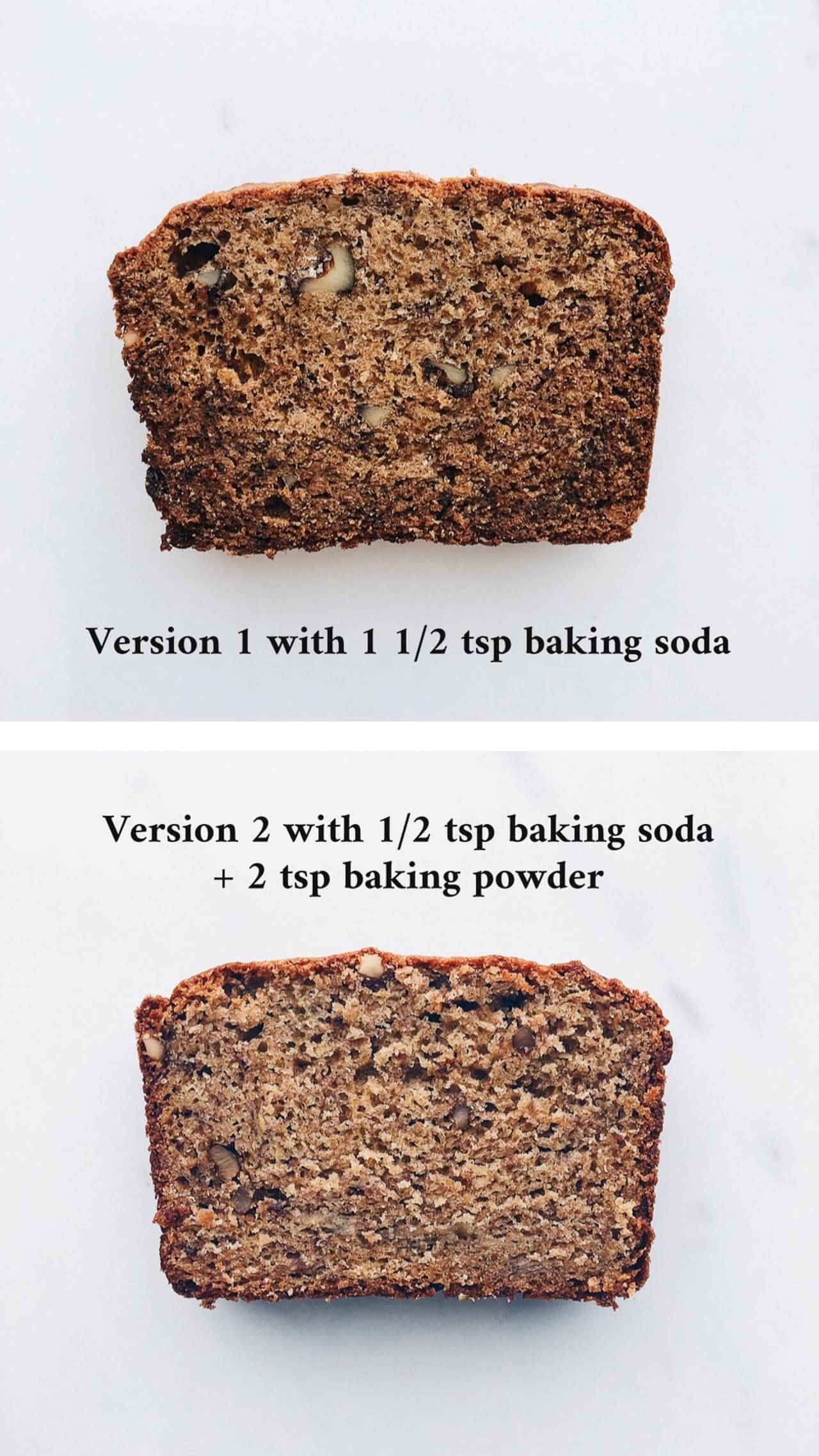
A darker pan will lead to faster browning
It's a fact that darker metal pans absorb more heat in the oven than lighter pans, and given that metal pans are great conductors, your banana bread will heat up faster on the edges if you bake it in a dark, metal pan. To avoid this, either bake it in a lighter pan OR lower the temperature of your oven by 25 ºF (so I would bake a banana bread in a light metal pan at 350 ºF but in a dark metal pan at 325 ºF).
What to do if it browns too quickly
The moment that you notice your banana bread is browning too quickly, you can tent it with a piece of foil to minimize further browning. You can also try dropping the temperature of the oven by 25 ºF. But other than that, there's not much you can do. And you can't remove it from the oven or stop baking the bread until you know it's baked in the middle, so the bread will darken further if there's still a lot of time left on your timer.
Next time, if you are using a darker pan, preheat your oven to 25 ºF lower than the original temperature and from the beginning. Also, take the time to analyze the ingredient list of your recipe: is there a lot of baking soda and little to no acid present in the recipe? Then maybe you could use a little less and swap in some baking powder.
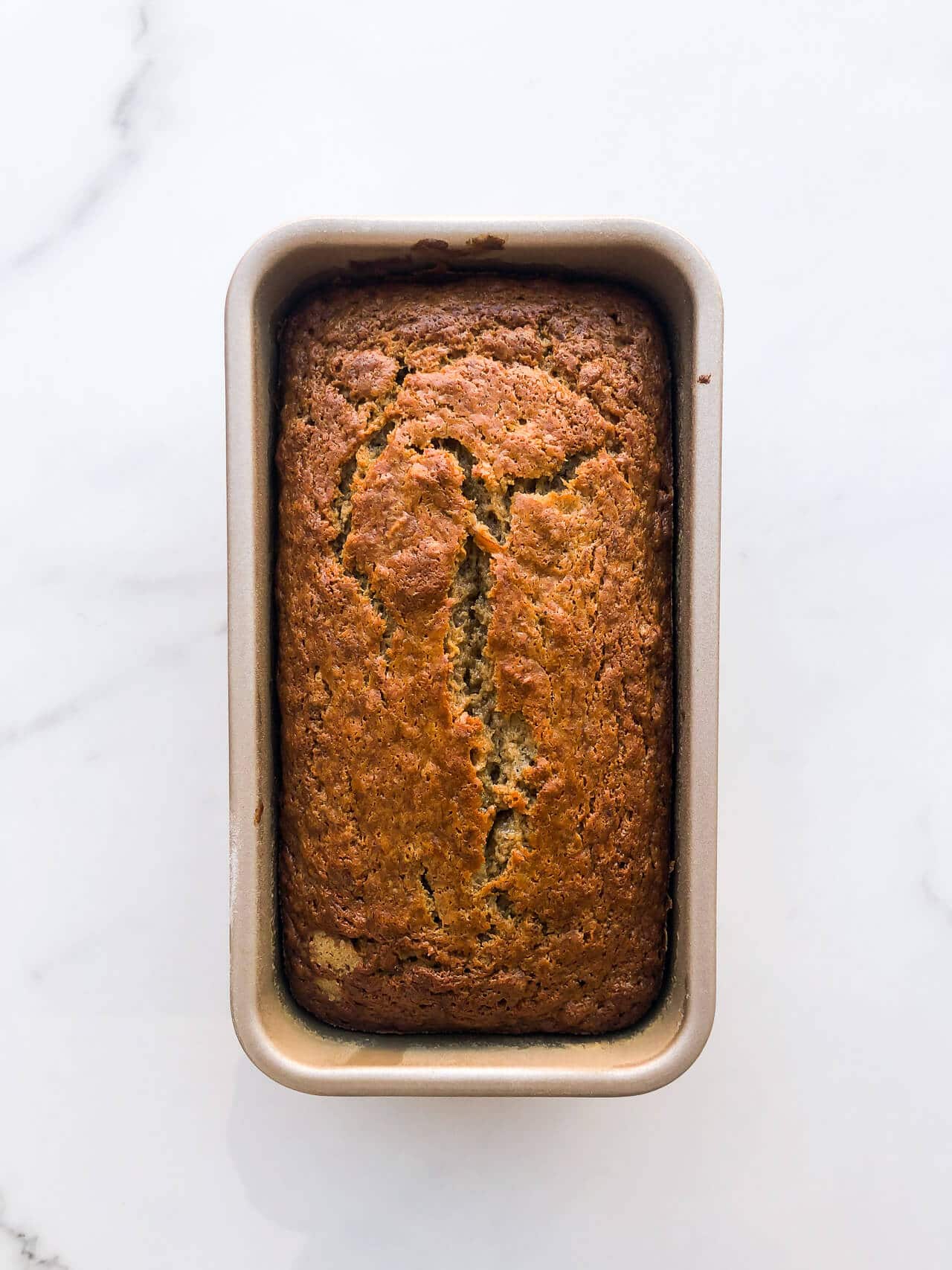
Problem #3: it doesn't rise
With leavening agents like baking soda and baking powder, a little goes a long way. On the other hand, if you don't add enough of these ingredients, your banana bread won't be able to rise.
Banana bread batter is particularly dense (as compared to a sponge cake or a flourless chocolate cake, where you incorporate a ton of air by whipping the eggs), especially when you think of the weight of the bananas added to the batter. You need a lot of rising power to be able to spring that cake batter up in the oven and to compete with gravity trying to pull the ingredients down.
The thickness and heavy-nature of the banana bread batter is why recipes call for more chemical leaveners than other cakes. Recall that the rule of thumb for how much chemical leavener to add to baked goods is roughly:
- ¼ teaspoon (1.25 mL) of baking soda for every 125 grams (1 cup) of flour
- 1 teaspoon (5 mL) of baking powder for every 125 grams (1 cup) of flour
With denser batters that require more "oomph," you might need to use more chemical leavener per cup to generate enough rising power and to properly leaven your banana bread. If you don't have enough, your banana bread won't rise.
Other options to consider if your banana bread doesn't rise:
- if you are using baking powder: make sure to test if your baking powder is still good
- if you are using baking soda: baking soda doesn't expire, though it can become clumpy which makes it impossible to incorporate into batters evenly, and this might result in an uneven rise.
What to do if your banana bread doesn't rise
If after a full hour of baking, your loaf cake hasn't risen, there's no fixing it at this point, sadly. But that doesn't mean all is lost. After cooling and slicing, perhaps you can toast slices in the oven to serve, or maybe toast cubes of the bread in the oven to use as sweet croutons to garnish yogurt bowls.
Even though you can't fix a banana bread that didn't rise, use this opportunity to check if your baking powder is still good and your baking soda too. You might need to replace them. Then analyze the recipe you used: are you sure there is enough leavening agent in the recipe for the quantity of batter?
Problem #4: there's a gummy layer towards the bottom of the loaf
On the outside, it can seem like your banana bread is perfectly baked, but then when you slice into it, you can see a line of under-baked batter that's settled at the base of the loaf cake. The gummy layer that can form on the bottom of a banana bread is so frustrating and it's a sign of a few possible problems:
- the loaf is underbaked: it takes an hour or more to bake most banana breads. Anything less can result in a gummy layer where the batter didn't dry up enough. Keep reading for how to tell if your banana bread is done.
- the banana bread batter was too wet:
- the recipe wasn't properly balanced with enough dry ingredients to compensate for all the moisture
- you used frozen bananas: defrosting bananas causes the cells of the fruit to break down, and then the bananas loose a ton of water. When baking banana bread with frozen bananas, you have 3 choices:
- Strain off the liquid and discard it (or you can freeze it in an ice cube tray and add it to smoothies if you don't want to waste it)
- Strain off the liquid, place the liquid in a saucepan and boil it down until you have just a couple tablespoons left, then add that bake to the bananas and proceed with the recipe
- Reduce the number of bananas you use: for a banana bread made with 190 grams (1-½ cups) of flour, don't use more than 1 cup of mashed banana, especially in recipes where there are other liquids present (like buttermilk, yogurt, or even sour cream). As a rule, when I make banana bread with 1-½ cups flour, I add up to a total of 375 mL (1-½ cups) of liquid ingredients (bananas+ sour cream). Anything more than that and you will most definitely end up with a gummy layer and you will have difficulties getting the loaf to bake properly in a reasonable amount of time without burning on the edges.
What to do if you notice a gummy layer at the bottom of your loaf cake
The good news is, your banana bread is still very much edible and you can enjoy it. If the gummy layer wigs you out, just eat around it. For next time, use less liquid, or less banana, or add more flour, or if you are using frozen bananas, consider straining the water from the defrosted bananas and either discarding it or boiling it down to concentrate it and remove as much water as possible.
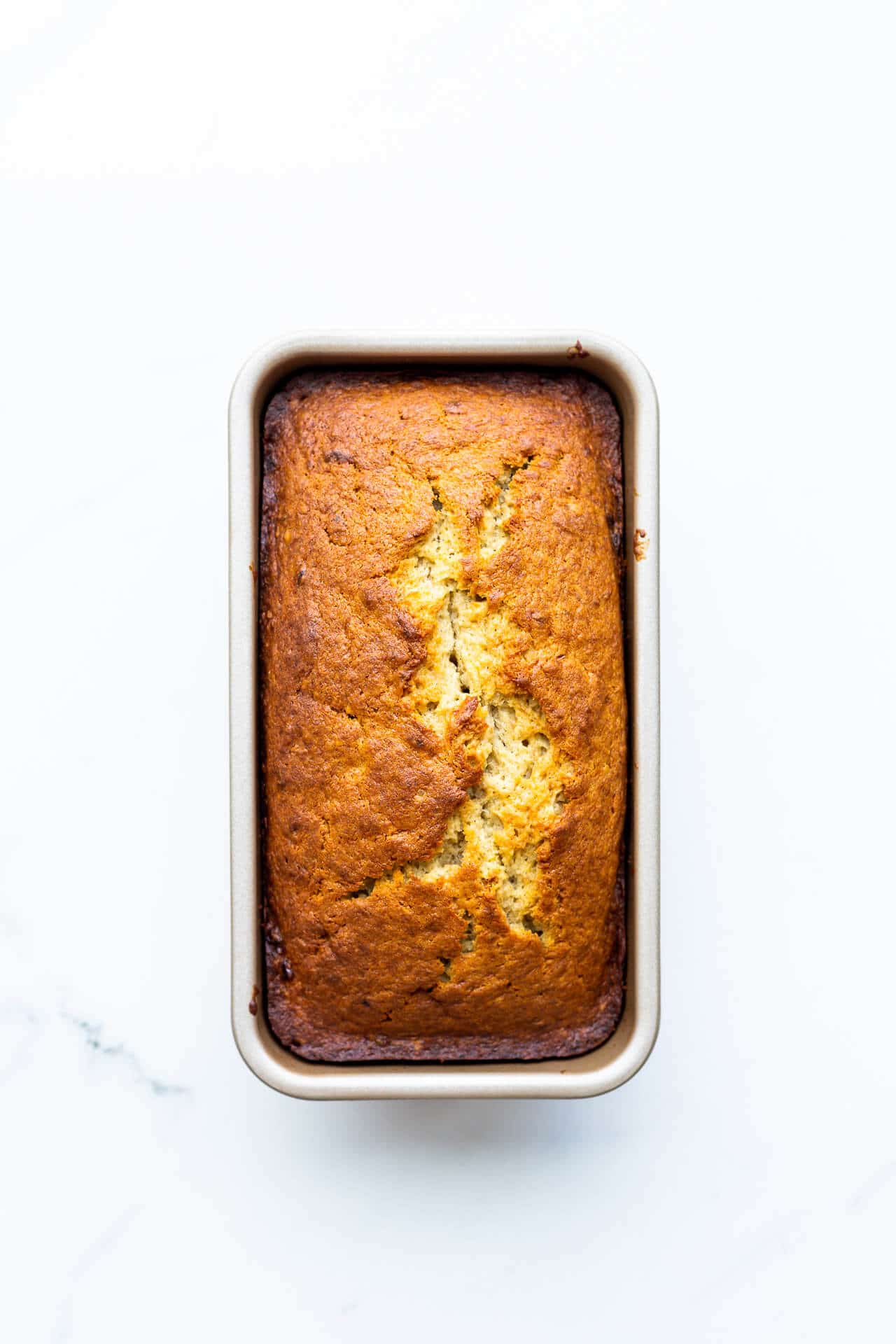
Problem #5: it doesn't taste like bananas
To me, when banana bread doesn't taste like banana, there is a real problem because don't we all want banana bread to taste like bananas? It's not that it tastes bad, but some recipes make banana breads that seem to taste more like gingerbread than anything else, and that off-flavour completely overpowers the bananas.
If your banana bread doesn't taste like bananas, look at your recipe again. I bet it has 1 teaspoon (or more) of baking soda and probably little to no acidic ingredients on the list (like buttermilk, yogurt, sour cream). Without an acid in your recipe, the baking soda has nothing to react with, and that excess of baking soda will carry over as it bakes, untouched, leading to a baking soda flavour that can verge on soapy if there's way too much left behind.
Sure, bananas can be slightly acidic, but if you are working with very ripe bananas, as you should be, there simply isn't enough acid to react with the baking soda. The unreacted baking soda will impart a flavour to your loaf of banana bread and that taste can mask the banana flavour completely.
How to improve the flavour of banana bread
If your banana bread tastes a lot like gingerbread and not like bananas, to me, this is a problem. If this happens to you, look at your list of ingredients: is there a large quantity of baking soda (at least 5 mL (1 teaspoon), or more) and no obvious acidic ingredients in the list? The baking soda is the ingredient that is changing the flavour profile of your recipe. Consider reducing the baking soda to 2.5 mL (½ teaspoon) or even as little as 1.25 mL (¼ teaspoon), and compensate for the loss of leavening by adding 2 teaspoons baking powder in its place.
If your banana bread doesn't taste like bananas, it could be that you didn't use bananas that were ripe enough. The flavour of a ripe banana is quite different than a green banana. Choose the ripest bananas possible. Some bakers recommend using bananas that are on the verge of over-ripe with completely black peels. In any case, don't use green bananas to make banana bread.
Techniques for ripening bananas
For banana bread, the riper the better. The banana peel should be extremely spotted, almost entirely coloured and on the verge of turning all black on the outside. The bananas will be soft on the inside.
If your bananas aren't ripe, the good news is that bananas continue to ripen after they are picked (unlike citrus fruits and grapes, for example). You can't speed up the process of ripening. You'll just have to be patient. There are some bakers that claim you can ripen the bananas by baking them in the oven but that doesn't make sense. Ripening is a biological process that transforms the fruit, making it sweeter and less acidic. Baking whole bananas can't mimic that process.
I usually wait several weeks for bananas to ripen, especially during the colder winter months and there isn't much you can do to reduce the time it takes. You can try placing the bananas in a paper bag with an apple. Apples release ethylene gas as they begin to decay, which promotes ripening of other fruit. Using an apple to ripen bananas would be a better option than baking the bananas and it's science.
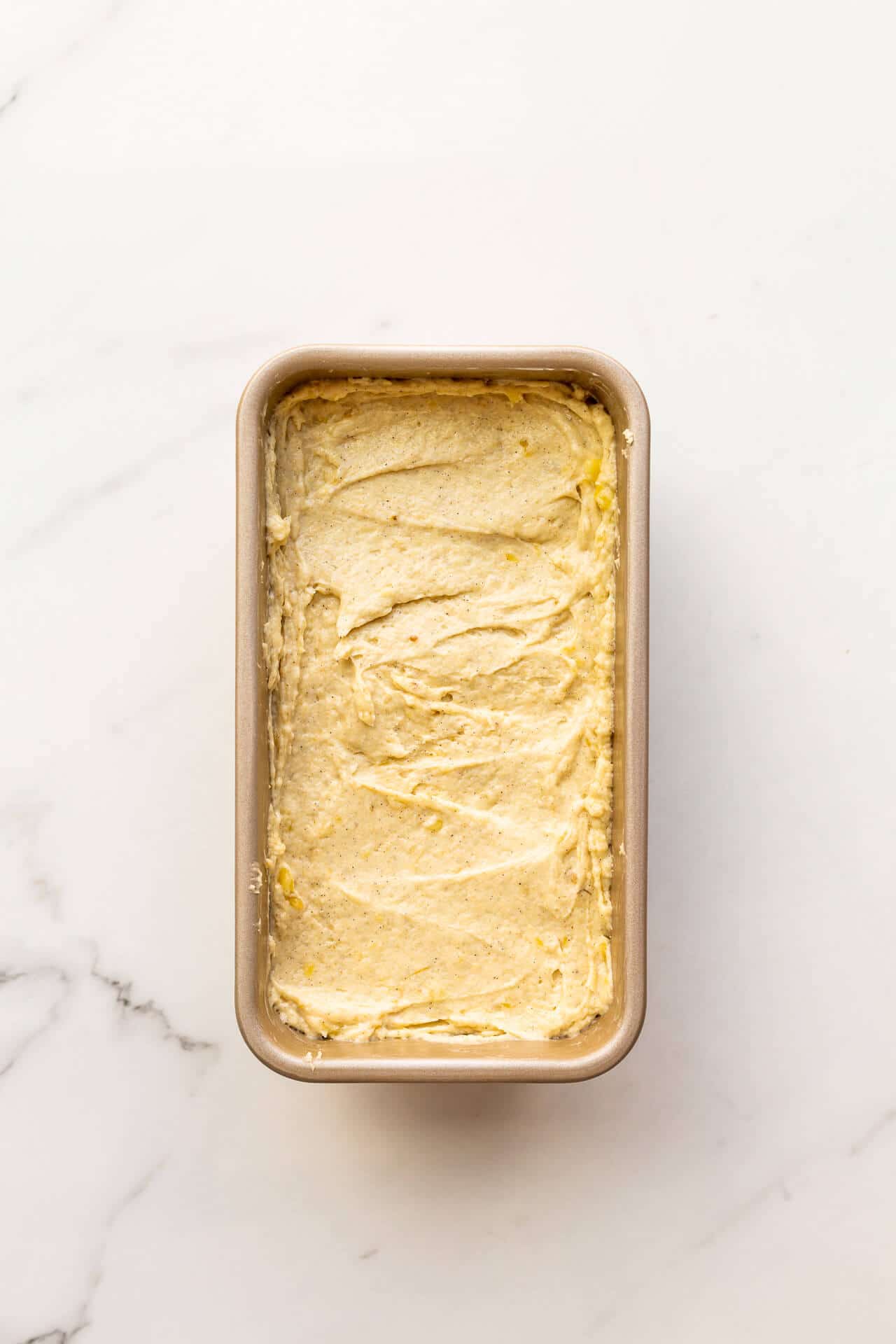
Problem #6: it's hard to tell when banana bread is baked through and done
How to tell if your cakes are baked through is a skill in itself. It can take a little experience, a few tricks, and also some trial and error. Trust me: I once baked a pound cake and completely misjudged whether or not it was baked, and when I inverted it onto a wire rack to cool, it was like cake batter from the middle came flowing out the cracks of the cake. It was a scene, so I can definitely relate to this problem.
How to check if it's baked enough
Loaf cakes in general (and banana cakes) can be tricky to check if they are baked through and done. Here are some clues you can use to check if your cake is done baking (or quick bread in this case):
- the edges should be a deep golden-brown and pulling away from the sides
- the edges of the cake should be pulling away from the sides
- the cake should bounce back when pressed gently with your finger tips
- a cake tester (metal skewer or wood skewer) inserted into the centre of the cake should come out clean
- a thermometer inserted into the middle of the cake should read around 100 ºC (212 ºF)
Problem #6: baking banana bread in different pans
As I mentioned before, banana bread recipes can be baked in muffin pans, cake pans, etc. But how do you adapt the baking time from one pan to another? It's a little tricky to give you an exact baking time for anything, even a banana bread baked in a metal 9x5-inch loaf pan. I made a banana bread yesterday in an 8.5"x4.5" OXO pan and it took 75 minutes to bake through, but if you bake it in a 9"x5" light metal loaf pan, it might take only 60 minutes. If you bake your banana bread in a glass Pyrex loaf pan, it could take longer actually because glass isn't a good conductor, though it will retain the heat of the oven for a long time when you take it out.
Suggested baking times for different pans
Here are some baking times to help guide you if you want to bake your banana bread in a different pan than usual. Remember the type of pan (metal vs glass, dark metal vs light metal), the height of the pan, how much you fill the pan, the ratio of wet ingredients to dry ingredients, etc. will all have an impact on your baking times. Make sure to use the clues above to help you judge doneness, along with the times below:
- For banana bread baked in a 9"x5" loaf pan, it takes about 60 minutes (or more) to bake at 350 ºF
- For banana bread baked in a 8.5"x4.5" loaf pan, it takes about 75 minutes to bake at 350 ºF
- For banana muffins baked in a regular size muffin pan, it would take roughly 25 minutes to bake at 350 ºF
- For banana cake baked in a square pan (like this banana snacking cake with chocolate fudge frosting), it takes about 35 minutes to bake a banana bread in a metal 9x9" square cake pan
- For banana cake baked in a round pan (like this monkey cake), it takes about 25 minutes to bake a banana bread in a metal 9" round cake pan
- For mini banana breads baked in mini loaf cake pans (like this cardamom banana bread), it takes about 30 minutes at 350 ºF
Problem #7: it seems a little dry inside
We can blame the perceived dryness of loaf cakes (and specifically banana breads) on a number of ingredients and steps:
- The fat used: Oil leads to a more moist cake and a lighter mouthfeel. Remember oil is fluid at room temperature, while butter is solid. This means that if you bake with butter, your cakes will be a little firmer or denser when they've cooled down to room temperature. On the other hand, oil-based cakes seem lighter and less dense because oil is quite fluid even at room temperature. If you aren't happy with the denseness or the perceived dryness of your cake, the butter might be to blame. Consider replacing half or all of it with canola oil (or another flavourless oil).
- There's not enough sugar in your recipe: some people cut down the sugar in banana bread recipes because bananas themselves are quite sweet. But the sugar not only contributes to the flavour of the cake, it also locks in moisture, improves preservation and increases the shelf-life of your cake, and with the creaming method, sugar helps you incorporate air into your cake batter. If you cut the sugar, there will be consequences, and one of them is that your cake will seem dryer.
- The mixing technique used: if you overwork your batter to mix the flour in with your wet ingredients, more gluten will develop, and this can lead to a tougher cake. I now fold in the flour using a silicone spatula to make sure to avoid over-mixing.
- It's over-baked: it's really hard to bake a banana bread through all the way to the middle, and sometimes, to avoid taking the cake out too early, we may end up over-baking the loaf to avoid problems. Use the tips I've listed above for how to check to make sure your banana bread is cooked just enough, but not too much.
📖 Recipe
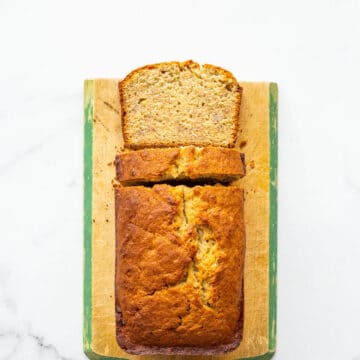
Basic Banana Bread
Ingredients
- 250 grams bleached all-purpose flour
- 10 mL baking powder
- 5 mL Diamond Crystal fine kosher salt
- 175 grams unsalted butter softened
- 200 grams granulated sugar or a mix of brown sugar and granulated sugar
- 2 large egg(s) room temperature
- 5 mL pure vanilla extract
- 330 grams mashed banana roughly 3 ripe bananas, approximately 450 grams with peel
Instructions
- Preheat the oven to 350 ºF (175 °C). Butter and flour a 1-pound loaf pan, either a 9x5-inch (23x12.5x7.5 cm) loaf pan (like this Nordic Ware pan on Amazon) or for a taller loaf, use an 8.5x4.5-inch (21.5x11.5x7 cm) loaf pan (like this Oxo pan on Amazon). Line the bottom with a rectangle of parchment. Set aside.
- In a medium bowl, whisk together the flour, baking powder, and salt.
- In a large bowl, using an electric hand mixer, cream together the butter and sugar for at least 5 minutes until light and fluffy. Be sure to scrape down the sides of the bowl often to make sure the mixture is evenly whipped.
- Add the eggs, one at a time, mixing in between each addition. Mix in the vanilla.
- Add the mashed banana. Mix well, scraping the bottom and sides to incorporate everything.
- Dump in the flour and fold it in with your spatula.
- Pour the batter into the prepared loaf cake pan. Smooth the top to even it out.
- Bake for 60–65 minutes for a 9x5" loaf or up to 75 minutes for an 8.5"x4.5" pan, until the edges are a deep golden brown and a cake tester inserted into the middle comes out clean.
Notes
- Use the largest bananas you can find for this recipe: I used a pound of bananas and after peeling, I was left with roughly 330 grams of fruit, which works out to 330 mL (1⅓ cups) but this recipe can accommodate up to 375 mL (1½ cups) of mashed banana. Don't use more than that.
- Make sure the bananas are very ripe (black even).
- If you are using frozen bananas for this recipe, please make sure do the following:
- defrost the bananas
- peel the bananas and place in a strainer set over a bowl
- press very gently to squeeze out the liquid
- either discard the banana liquid OR place the liquid in a saucepan and boil it down to a couple tablespoons, stirring often so that it doesn't burn. Add this banana concentrate to the bananas and proceed with recipe.
- If you want to make a fancier banana bread, add any of the following:
- add 250 mL (1 cup) chocolate chips
- add 250 mL (1 cup) chopped walnuts or chopped pecans
- add 5 mL (1 tsp) ground cinnamon
- add 10 mL (2 tsp) ground cardamom
- add 5 mL (1 tsp) vanilla extract
- You can also use a thermometer to check if your cake is done baking and the internal temperature should register around 212 ºF or 100 ºC when it's done.
- If you don't have eggs or are allergic, try this eggless banana bread recipe.

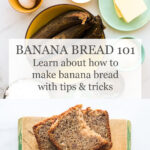

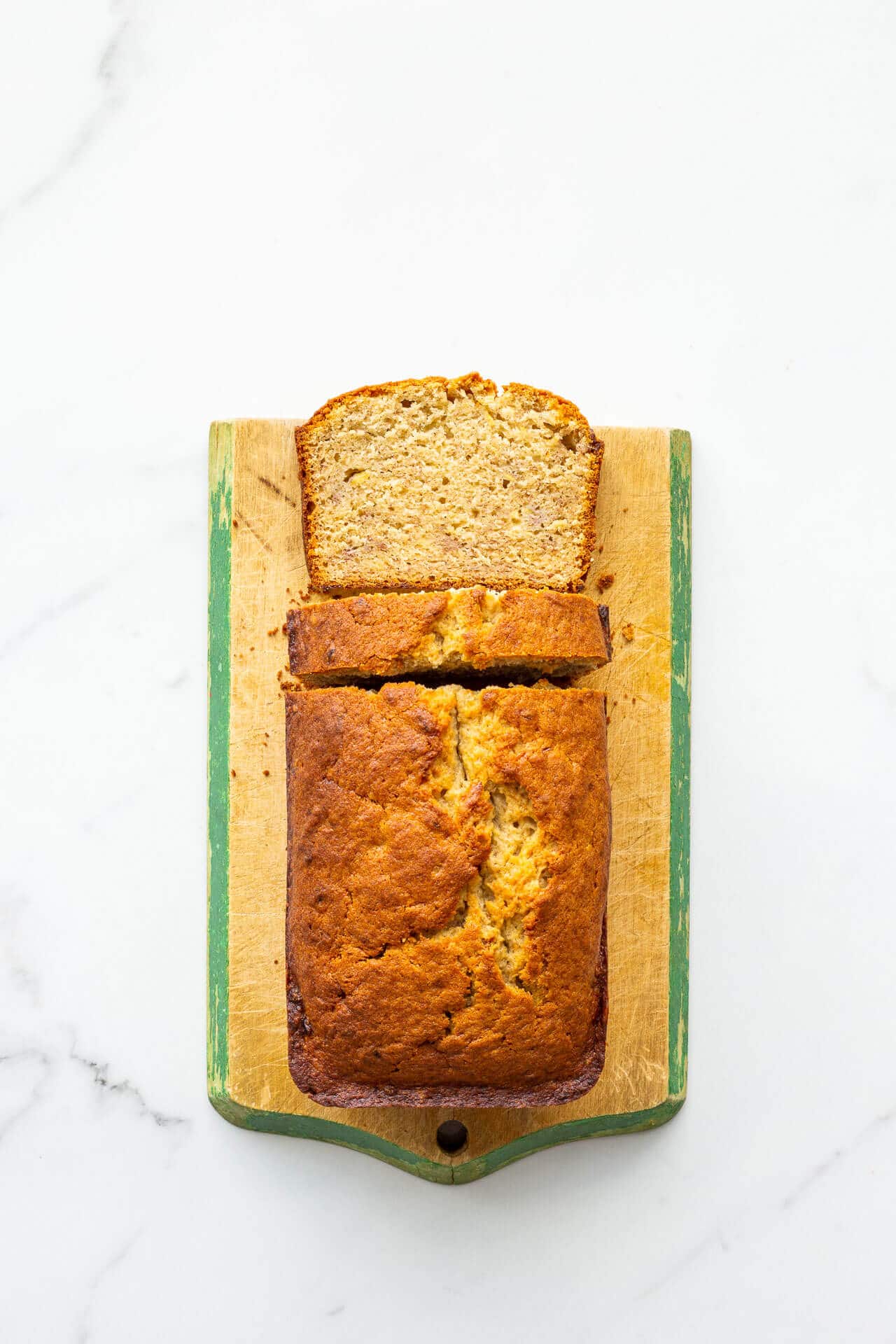
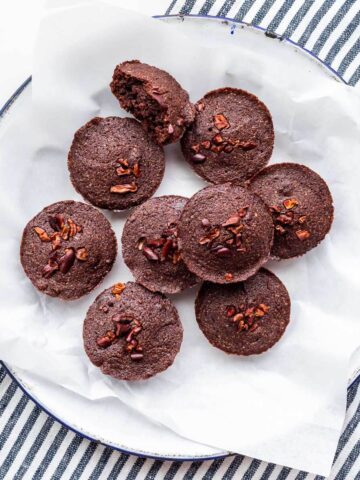
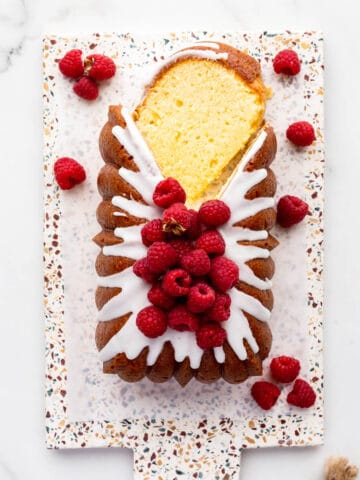
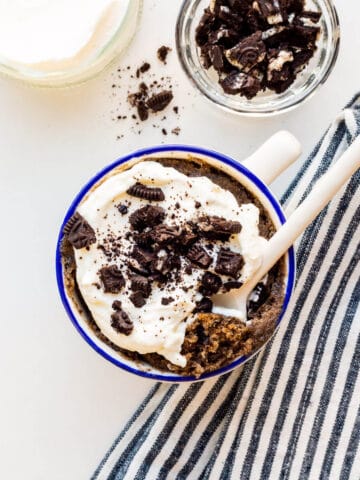
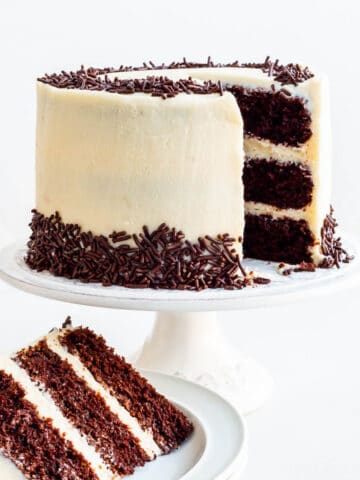
Leeann says
If using the traditional banana bread recipe using dry ingredient measurements of 1 1/2 cups Flour, 1 tsp Baking Soda, 1/2 Salt AND an additional acidic component such as sour cream am I still able to add baking soda as an additional leavened and how much can/should I add? I’m 90% happy with my banana bread but would like just a smidge more lift
Janice Lawandi says
Hi! I'd try a combination of baking soda and baking powder. If you like the taste with 1 teaspoon baking soda but want more lift, try also adding 1 teaspoon baking powder. The combination may help you get more lift, especially later in the baking time since most baking powder formulas take heat to react.
billie says
Something went horribly wrong...dark crispy outside, very undone center of metal loaf pan. I have to say the outside slightlycrispy part was really good (I like my baked goods with a bit of crunch like brownie corners) and the flavor was really good... I am away from home for 2 years without my tried and true so I try a lot of internet recipes. Hits and misses. Too time consuming with only 1 pan and needing to make a bunch. Benefit of the doubt maybe I measured wrong but I was extremely careful.
Janice Lawandi says
Hi Billie,
I'm very sorry that happened! It honestly sounds like your oven was too hot if the outside got so dark and the inside was raw. Do you have an oven thermometer to verify that your temperature setting matches the actual temperature in the oven after preheating for 30 minutes? You may need to adjust accordingly.
Another idea: if you used a pan that was too small for the amount of batter, this could also have happened because the inside wouldn't have enough time to bake while the outside is overdone.
What colour is the loaf pan? If it has a dark finish, dropping the oven temperature by 25 °F will allow you to bake the loaf for longer while slowing the browning.
I wish I had a firm answer for what you experienced, but hopefully these ideas will help you figure out what went wrong.
Xavier Baker says
Aloha from Maui Hawaii;
So I bake Banana Bread every other week and I typically have a problem with stirring the wet into the dry ingredients, my question is the process would I stir with a whisk until I cannot see any more flour in the batter and its incorporated? or would it best to use a spatula as you mention and fold everything together? but my concern is how many times would I fold it or how many mins. I typically come out with a spongy texture a lot, or my Banana Bread isn't moist and a bit hard when I take it out of the oven considering I set it to 350 but my oven gets way Hot than necessary
Amy says
Hey! The eggless banana bread is awesome! Just curious - what's the reason for baking soda in the eggless one and baking powder in the regular one?
Thanks!
Janice says
Hi Amy, I'm so glad you enjoyed the eggless banana bread! The recipe calls for baking soda because that's how my mom made it. I was tempted to do more tests with baking powder to compare the two, but I didn't in the end because we enjoyed it so much this way. I probably will do the test eventually, and when I do, it's likely I'll try omitting the baking soda and using 10 mL (2 teaspoons) baking powder instead to see if that works too... hope that helps!
Vimal says
This was probably the best recipe for banana bread I've tried. Turned out perfectly and I followed directions precisely including whipping the butter and sugar together first. Also, took the liberty to add fresh blueberries and pecans. Used 3 ripe bananas and the flavor of the banana was on point. Did have to bake for 70 min and resulted in the perfect texture and color. This will be my go to recipe for banana bread because it was literally perfect!